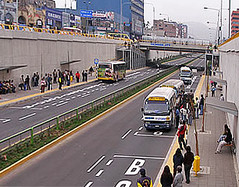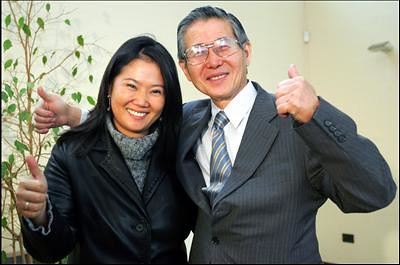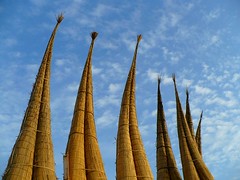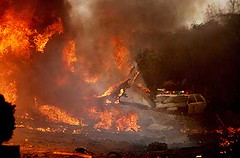New royal Sicán tomb discovered in Bosque de Pomac
The Pomac Forest, first home of the Sicán civilisation, has revealed another ancient secret. Under Las Ventanas, one of several adobe pyramids that poke out above the dry forest’s trees, one of the most ancient tombs of the elite has been discovered.
By Wilfred Sandoval, Photos by Richard Hirano
In 1991 the Ministry of Agriculture ordered the construction of a levee along the edge of the river La Lechethat runs through the heart of the natural and archaeological reserve in order to help alleviate the damage done by the regularly overflowing river. More than once have heavy rains and the river bursting its banks have destroyed large portions of the Sicán-era pyramids. The levee, it was discovered afterwards, turned out to have been built in an area where one of the lower platforms of pyramid Las Ventanas extended out to.
It is here, in this section of the pyramid now damaged by both man and nature, that researchers from the Sicán Museum have made one of the most surprising discoveries.
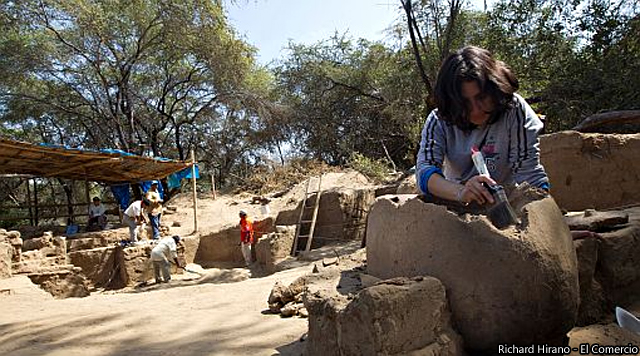
When work to rescue this part of the pyramid began, archaeologists only expected to find destroyed and fairly insignificant objects. First they registered dozens of ceramic items, and some silver and gold ones, but as expected, the context had been lost due to the damage by the construction work.
While registering these bits and pieces scattered across the area, one object in particular, something ceramic with an orange tint to it at 20cm deep, caught the attention of archaeologist José Pinilla. The reason? It was intact!
When uncovered it wasn’t just any ceramic object, but was exquisitely made with four faces in high-relieve showing the Moche god Ai Apaec. According to Pinilla this is a first for a Sicán tomb in Lambayeque. Unfortunately we’ll never be able to find out more about the elite that it belonged to, the rest of the site was completely destroyed by the heavy construction machinery.
A great surprise
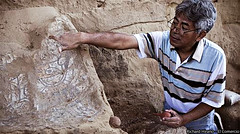 Some 25 metres to the south of the pyramid, other clues created excitement in workers under the supervision of archaeologist Carlos del Carpio Sedano.
Some 25 metres to the south of the pyramid, other clues created excitement in workers under the supervision of archaeologist Carlos del Carpio Sedano.
First they found scattered bone fragments, then some metres deeper two ceremonial knives made of copper accompanied by crucibles. These too seemed to form part of a destroyed tomb of someone important.
Fight against erosion
Authorities recognise that the work realized to protect the huaca Las Ventanas have not been effective, despite more than 30,000 sand bags being used as part of the contention wall.
This past March a crown-like object made of copper was uncovered which in turn led to something the archaeologists didn’t expect: the remains of an elite that would have ruled before the famous Lord of Sicán, located here 1.5km from his descendant’s tomb. Buried in a seated lotus position, the elite died around 1200 years ago.
From the moment of the discovery Del Carpio Sedano’s excitement has been multiplying, it’s the first time in his career that he has witnessed an example of a famous Sicán face mask emerge from the ground.
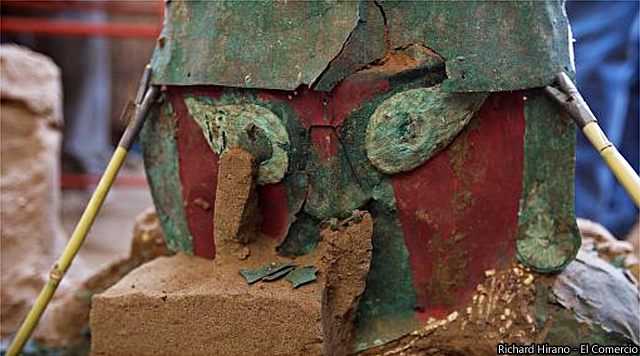
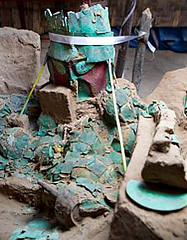 Among the treasures uncovered are a ceremonial turquoise and spondylus pectoral armour plate, a ceremonial knife and seven fine ceramic items. But standing out were the gold tweezers shaped in the form of a bird that ancient Peruvians used to remove facial hair.
Among the treasures uncovered are a ceremonial turquoise and spondylus pectoral armour plate, a ceremonial knife and seven fine ceramic items. But standing out were the gold tweezers shaped in the form of a bird that ancient Peruvians used to remove facial hair.
Although as yet it is not known exactly what else accompanies the burial, the site archaeologists explain that the bundle was covered with a large unku – an alpaca blanket known better in Spanish as a poncho. The unku had false arms attached, and these were covered with feather-shaped pieces of copper and gloves, all very well preserved.
World headlines in the 1990s
In the 1990s in another nearby pyramid, the famous East Tomb was discovered, making headlines around the world for the 1250 kilograms of gold and silver objects that were excavated.
Archaeologists Carlos Elera, José Pinilla and Carlos del Carpio all agree that it was nothing less than a miracle that this elite sicán ruler was not lost forever in the destruction caused by nature’s flooding and man’s feeble attempt to stop it.
Recognising the importance of the discovery, Carlos Elara, the director of the Sicán Museum in Ferreñafe, has put in a request to the government to declare the area of the find to be an emergency zone. This status would release extra funds and security to quickly and carefully advance the progress of the work before another imminent overflowing of La Leche river.
According to the researchers, it seems many other tombs have destroyed by the river over many kilometres since the civilisation collapsed, but they have also now detected the presence of other intact tombs under the riverbed.
Tags: batan grande, bosque de pomac, chiclayo, lambayeque, pyramids, ruins, sican, tomb





